 NATURE
HAPPENINGS - October 2002
NATURE
HAPPENINGS - October 2002
Mountain Kings
by Damian Fagan
Their intent is to startle and
most times they are successful. As we walk through the aspens in
October, our serenity is interrupted by a flurry of wings as a blue
grouse explodes out of the understory. The birds wait until they
are nearly underfoot, then burst forth and fly a short distance.
Their effect is to create a momentary diversion, throw a predator
off of their scent, and make their escape.
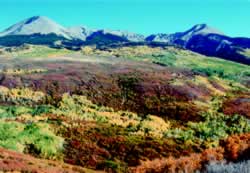 The
blue grouse is the common, montane grouse of the Intermountain West.
The genus name Dendragapus means “tree-loving” while the
species name, obscurus, means “inconspicuous” - both define
this bird of the aspen-fir forests. The inconspicuous label relates
to the females mottled color and the solitary nature of the adult
males. Blue grouse are also called “hooters” because of
their owl-like calls.
The
blue grouse is the common, montane grouse of the Intermountain West.
The genus name Dendragapus means “tree-loving” while the
species name, obscurus, means “inconspicuous” - both define
this bird of the aspen-fir forests. The inconspicuous label relates
to the females mottled color and the solitary nature of the adult
males. Blue grouse are also called “hooters” because of
their owl-like calls.
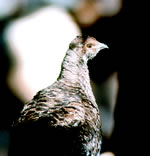 A
round-winged, chicken-like bird, the stocky blue grouse may be up
to 17 inches tall. Both sexes have a long, squarish tail, tipped
with gray. While the females are not colorful - better to be camouflaged
on the nest - the males are also gray or sooty in color, but with
an orange or yellowish colored “comb” of bare skin above
their eyes. These “eyebrows” would have made Groucho Marx
jealous.
A
round-winged, chicken-like bird, the stocky blue grouse may be up
to 17 inches tall. Both sexes have a long, squarish tail, tipped
with gray. While the females are not colorful - better to be camouflaged
on the nest - the males are also gray or sooty in color, but with
an orange or yellowish colored “comb” of bare skin above
their eyes. These “eyebrows” would have made Groucho Marx
jealous.
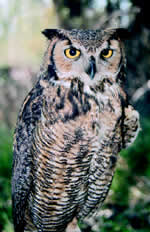 Blue
grouse do not congregate at strutting grounds or leks like their
grassland or prairie-dwelling relatives. Males perform a solitary
display (or with a couple of onlookers) by spreading its tail feathers
into a wide fan. The male then spreads the feathers on the side
of its neck exposing a purplish skin - birds in the Pacific region
have a yellower patch of skin. With this “look at me”
posture, the male rushes forward in a short dash. The performanceis
accompanied by a series of loud hoots, aimed at attracting a mate.
Blue
grouse do not congregate at strutting grounds or leks like their
grassland or prairie-dwelling relatives. Males perform a solitary
display (or with a couple of onlookers) by spreading its tail feathers
into a wide fan. The male then spreads the feathers on the side
of its neck exposing a purplish skin - birds in the Pacific region
have a yellower patch of skin. With this “look at me”
posture, the male rushes forward in a short dash. The performanceis
accompanied by a series of loud hoots, aimed at attracting a mate.
 For
nests, blue grouse females use a shallow depression at the base
of a tree or near a fallen log or rock. They line the nest with
grasses, pine needles orleaves, and deposit around a dozen buff-colored
eggs dotted with brown.The female does all the incubating, up to
26 days, and will raise her nestlings solo. Mortality can be high
on the nestlings, with foxes, coyotes, owls or hawks preying on
the young birds.
For
nests, blue grouse females use a shallow depression at the base
of a tree or near a fallen log or rock. They line the nest with
grasses, pine needles orleaves, and deposit around a dozen buff-colored
eggs dotted with brown.The female does all the incubating, up to
26 days, and will raise her nestlings solo. Mortality can be high
on the nestlings, with foxes, coyotes, owls or hawks preying on
the young birds.
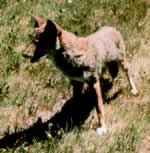 During
the fall, blue grouse feed on available berries, flowers and leaves
of plants, and insects. As snows start to cover the high country,
their diets change to conifer needles and buds. Birds may be seen
eating grit off of roadways which helps grind up seeds and plant
material in the bird’s stomach.
During
the fall, blue grouse feed on available berries, flowers and leaves
of plants, and insects. As snows start to cover the high country,
their diets change to conifer needles and buds. Birds may be seen
eating grit off of roadways which helps grind up seeds and plant
material in the bird’s stomach.
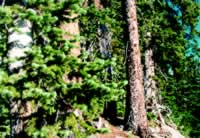 Though
winter may seem harsh at 10,000 feet, the blue grouse doesn’t
migrate from this snowy landscape to balmy southern lands. Some
elevational migration may take place as the birds move a bit downslope,
but for the most part this bird is well adapted to its wintery domain.
Though
winter may seem harsh at 10,000 feet, the blue grouse doesn’t
migrate from this snowy landscape to balmy southern lands. Some
elevational migration may take place as the birds move a bit downslope,
but for the most part this bird is well adapted to its wintery domain.
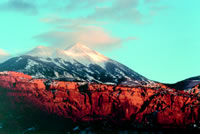 But
for the time being, as we continue along the trail toward Burro
Pass in the La Sal Mountains, we keep a watchful eye out for these
heart-stopping explosions of feathers. We envy these birds, as faded
aspen leaves pirouette earthward, and their ability to dwell here
at high up in the home of the mountain kings.
But
for the time being, as we continue along the trail toward Burro
Pass in the La Sal Mountains, we keep a watchful eye out for these
heart-stopping explosions of feathers. We envy these birds, as faded
aspen leaves pirouette earthward, and their ability to dwell here
at high up in the home of the mountain kings.